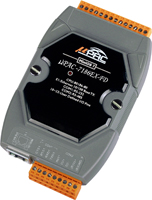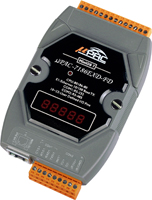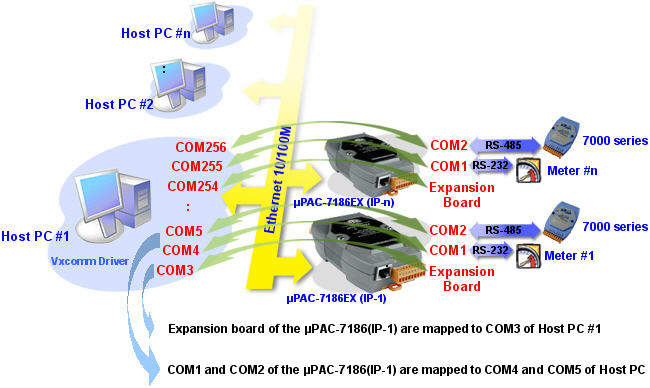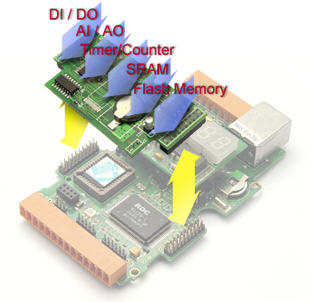μPAC-7186PEX/μPAC-7186PEXD
Programmable Automation Controller |
|
| |
 |
 |
Model: μPAC-7186PEX |
Model: μPAC-7186PEXD |
|
|
|
|
| |
 |
The μPAC-7186PEX is a palm-size programmable automation controller that with Ethernet, RS-232, RS-485 communication. ICPDAS provide easy-to-use software development tool kits (Xserver, VxComm, Modbus libraries). Users can use them to easily integrate serial devices to have Ethernet/Internet communication ability and through the standard Modbus protocol to communicate with SCADA software (Indusoft, ISaGARF, DasyLab, Trace Mode, Citect, iFix, etc.).
For the hardware, it also supports an I/O expansion bus. The I/O expansion bus can be used to implement various I/O functions such as D/I, D/O, A/D, D/A, Timer/Counter, UART, flash memory, battery backup SRAM, ASIC key & other I/O functions. Nearly all kinds of I/O functions can be implemented by this bus but the bus can support only one board. There are more than 50 boards available for μPAC-7186PEX, you can choose one of them to expand hardware features.
Power-over-Ethernet (PoE) allows power and data to be carried over a single Ethernet cable, so a device can operate solely from the power it receives through the data cable. This innovation allows greater flexibility in office design, higher efficiency in systems design, and faster turnaround time in set-up and implementation. |
| |
 |
Support PoE
The μPAC-7186PEX feature true IEEE 802.3af-compliant (classification, Class 1) Power over Ethernet (PoE) using both Ethernet pairs (Category 5 Ethernet cable). μPAC-7186PEX can receive power from an auxiliary power sources like AC adapters and battery in addition to the PoE enabled network. This is a desirable feature when the total system power requirements exceed the PSE's load capacity. Furthermore, with the auxiliary power option, the μPAC-7186PEX can be used in a standard Ethernet (non-PoE) system. |
| |
| Support for Virtual COM technology |
Using the VxComm technology, PC can create virtual COM ports to map the RS-232, RS-485 of theμPAC-7186PEX. The software running on the PC can operate the virtual COM ports like a standard COM port to access the serial devices connect to the μPAC-7186PEX. That is to say, the original software developed for the serial devices can access the serial devices via the Ethernet/Internet without any modification.
Each PC can control up to 256 COM ports (including real COM ports). Using the I/O expansion board, each μPAC-7186PEX can have up to 8 COM ports. |
 |
|
| Support Modbus Protocol |
Using the Modbus firmware, μPAC-7186PEX offers following Modbus features:
- Modbus/TCP/RTU/ASCII slave
- Modbus/TCP/RTU/ASCII master
- Gateway for Modbus/TCP to Modbus/RTU
|
|
| Easy-to-use software development tool kits (using C language) |
| If the default firmware does not totally fulfill the user's application needs, custom firmware can be developed for μPAC-7186PEX using the SDK (Xserver, Modbus library) provided by ICPDAS. |
|
| Ethernet Protocols |
| TCP, UDP, IP, ICMP, ARP |
|
| Support Web Configuration |
| μPAC-7186E has a built-in web server for configuration. You can use standard web browsers (such as IE, Netscape, Firefox,..etc) to configure its Ethernet and COM ports configurations. |
|
| Remote Configuration/Maintenance |
| μPAC-7186PEX can be operated via the Ethernet (TCP/IP or UDP) or RS-232, to allow tasks such as downloading programs, configuration, updating the MiniOS7, etc. |
|
| Built-in watchdog timer (WDT) |
| μPAC-7186PEX include an internal watchdog timer (WDT). The watchdog timer will trigger a system reset if the main program fails or neglects to regularly service the watchdog. The intention is to bring the system back from the hung state into normal operation. |
|
| I/O Expansion Bus Interface |
| The μPAC-7186PEX support the use of an I/O expansion bus to add a single I/O Expansion Board. ICPDAS provides all function libraries for I/O Expansion Boards to enable easy use of the I/O Expansion Board functions. |
 |
|
|
|
| |
 |
| CPU |
| CPU |
80186 or compatible (16-bit and 80 MHz) |
| SRAM |
512 KB |
| Flash |
512 KB; Erase unit is one sector (64K bytes); 100,000 erase/write cycles. |
| EEPROM |
16 KB
Data retention: 40 years; 1,000,000 erase/write cycles. |
| NVRAM |
31 Bytes (battery backup, data valid up to 10 year) |
| RTC (Real Time Clock) |
RTC Provide seconds, minutes, hours, date of week/month; month and year, valid from 1980 to 2079 |
| 64-bit Hardware Serial Number |
Yes |
| Built-in Watchdog Timer |
Yes (0.8 second) |
| Communication Interface |
| COM1 |
RS-232 (TxD, RxD, CTS, RTS and GND); Non-isolated |
| COM2 |
RS-485 (D2+, D2-; self-tuner ASIC inside); Non-isolated |
| Ethernet Port |
10/100Base-TX Ethernet Controller
(Auto-negotiating, Auto_MDIX, LED indicator) |
| COM Port Formats |
| Data bit |
7, 8 |
| Parity |
Even, Odd, None |
| Stop bit |
1 |
| LED Display |
| 5-Digit 7 Segment LED Display |
Yes (for μPAC-7186PEXD only) |
| System LED Indicator |
Yes (Red) |
| PoE LED Indicator |
Yes (Green) |
| Hardware Expansion |
| I/O expansion bus |
Yes |
| User defined I/O pins |
14 pins |
| Dimensions |
| W x H x D |
72 mm x 123 mm x 35 mm |
| Operating Environment |
| Operating Temperature |
-25°C ~ +75°C |
| Storage Temperature |
-40°C ~ +80°C |
| Relative Humidity |
5 ~ 90% RH, non-condensing |
| Power |
| Protection |
Power reverse polarity protection |
| Input Range |
PoE |
IEEE 802 3af, Class 1 |
| Terminal block |
+12 ~ 48 VDC (non-regulated) |
| Power consumption |
1.5 W for μPAC-7186PEX
2.5 W for μPAC-7186PEXD |
|
| |
 |
| μPAC-7186PEX CR |
Palm-size μPAC with PoE (RoHS) |
| μPAC-7186PEXD CR |
μPAC-7186PEX with 7 segment LED display |
|
| |
 |
| NS-205PSE CR |
Industrial 5-Port PoE Ethernet Switch |
| DIN-KA52F-48 |
48 V/0.52A, 25 W Power Supply with DIN-Rail Mounting |
| MDR-60-48 |
48 V/1.25 A, 60 W Power Supply with DIN-Rail Mounting |
| I/O Expansion Boards |
Other add-on expansion boards refer to expansion board selection guide |
|
| |
|
|
| |
|
|